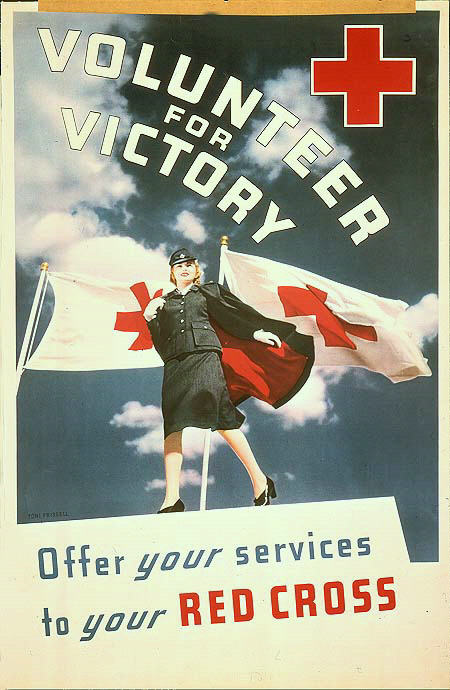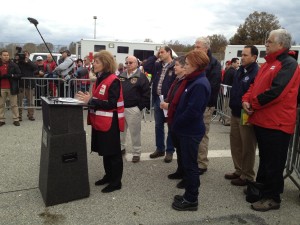Motherhood, apple pie and the Red Cross

World War II poster, the mom and apple pie iconic image of the Red Cross. Photo: Library of Congress via Wikipedia.
Icons of American life. Except the Red Cross seems to fall off its pedestal on a pretty regular basis in recent years. The current CEO Gail McGovern was brought on board in 2008 to help clean up the organization’s post-Katrina public image and public trust problems that surfaced during that disaster. She may have taken the image buffing charge a bit too much to heart, or too literally. In research and a story released on the occasion of the second anniversary of Hurricane Sandy, some disturbing priorities funded by the Red Cross under McGovern’s leadership:
Red Cross officials at national headquarters in Washington, D.C. compounded the charity’s inability to provide relief by “diverting assets for public relations purposes,” as one internal report puts it. Distribution of relief supplies, the report said, was “politically driven.”
During Isaac, Red Cross supervisors ordered dozens of trucks usually deployed to deliver aid to be driven around nearly empty instead, “just to be seen,” one of the drivers, Jim Dunham, recalls.
And, this:
During Sandy, emergency vehicles were taken away from relief work and assigned to serve as backdrops for press conferences, angering disaster responders on the ground.

Red Cross CEO Gail McGovern speaks at a post-Sandy press conference on Staten Island with emergency response vehicles as backdrops. Relief workers were angered that the vehicles were diverted for public relations purposes. (Via ProPublica: Catherine Barde/American Red Cross via Flickr)
This story has received a lot of attention following the coverage on NPR and via ProPublica. You may have heard the NPR coverage on the news programs this week. I urge you to check the extensive article at ProPublica if you’re interested in this story.
Certainly the Red Cross has done important, life-saving work over the years. But Ms. McGovern’s attention to branding and heavy investment in PR to elevate the organization’s image has been counter-productive. Everyone knows the Red Cross does good stuff. The best way to advance its image is to continue to do that work, and more of it–by spending far less on PR and at least 80% on the job of helping people.
I have a couple of dogs in this race. Back in ’98, during the ice storm that left huge swaths of the north country and eastern Ontario and western Quebec without power for as much as three weeks, the compelling takeaway was how quickly local volunteer fire departments and churches organized to provide relief to their communities. What they needed more than anything else was rapid response from the Red Cross to bring needed supplies into the region. That isn’t quite what happened. The Red Cross was relatively slow to respond and then the supplies had to be distributed on Red Cross terms, rather than allowing already effective and locally knowledgeable volunteers to proceed with their own methods. The Red Cross left a lot of ill-will in the wake of their presence in the north country.

As far as I’m concerned, this is all the branding the Red Cross needs…if it’s doing its job well. Photo: public domain
More recently, both FEMA and the Red Cross failed to deliver critical relief to the poor coastal neighborhoods outside of NYC. My son, who lives in Manhattan, has traveled to Far Rockaway every Sunday for the past year to help rehab housing, build pocket parks, playgrounds and gardens for the families who received no help in the wake of Hurricane Sandy. Elsewhere in the state, politicians showed up to hand out money and promises to rebuild, while middle class or wealthier residents figured out how to access assistance from FEMA, and the Red Cross was visibly present. In Far Rockaway, it’s been crumbs–and the most help has once again come from local churches and community groups that just rolled up their sleeves and pitched in. No politically influential photo ops in Far Rockaway.
Mom and apple pie continue to hang in there without needing brand repair because they make their branding point by being what they are–Mom loves you regardless of your flaws and apple pie is just darn good to eat. Instead of spending time and money telling you what the brand is, maybe the Red Cross could learn something from mom and apple pie by simply doing what we all think the Red Cross does with its money.
Tags: disaster relief, FEMA, Hurricane Isaac, Hurricane Sandy, NPR, propublica, Red Cross








I think in general our disaster response mechanisms don’t work very well nationally, the Red Cross at the national level (the local chapters seem fine) have been screwed up for decades. I remember Dole trying to fix things, they are always bringing some new CEO in to “clean things up”, at some point the problem is more than a new CEO.
Someone needs to ask about the truck loads of food delivered to the NAACP HQ rather than to the victims in need the food???? Why volunteers were left to fend for themselves with no clear leadership with the ability to make a decision. Caring willing concerned volunteers reprimanded for asking questions about the waist, volunteer abuse, misuse of Red Cross equipment and the almighty donated dollar that is the driving force of the day to day operations at the local chapter.
As above so below.
Poking around the local chapters could prove to be very enlightening. The local chapters have been taken over by national, monies donated for a disaster or to a local chapter are grabbed up for Nationals general fund. Nickels of the donated dollar are passed out to victims (clients). Where is the accountability, who can over see New American Red Cross? The New American red cross is no longer a volunteer friendly place to serve or to give…
Yeah, its too bad. In their defense, they are not a government agency, they are utilizing private donated dollars not government subcontracts; they are under no obligation to show up at all, if the donations stop they go nowhere. What they should do is scale their operations to a size that is doable for them. Also I think they should build the local chapters to help the local communities; and de-emphasize the national organization, which is really mainly administrators and fundraisers. There is no big building with a bunch of disaster experts waiting to spring into action. As you know it is volunteers who they call up and then send around the country, all of that takes time and logistics, and they have shown that they are not up to the task.